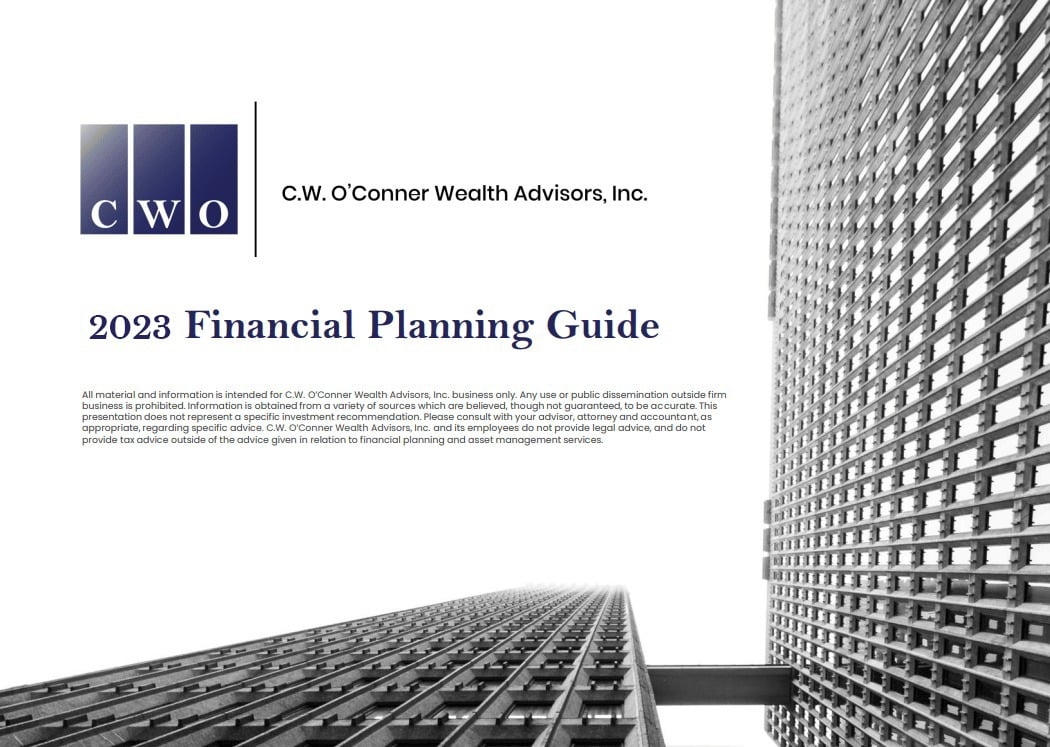
In the realm of savvy financial tactics, “bunching” charitable donations stands out as a particularly smart move. This strategy offers an opportunity to donate multiple years’ worth of charitable gifts in a single year, amplify your impact on the causes you care about, and save big substantially on your next tax bill. Below, you’ll learn more about this charitable giving strategy, how it works, its pros and cons, and how you can get help using it yourself.
Table of Contents
- 1 What is a Charitable “Bunching” Tax Strategy?
- 2 How Does Bunching Charitable Donations Work?
- 3 Bunching Charitable Donations Rules
- 4 Bunching Charitable Donations Pros and Cons
- 5 Bunching Charitable Donations with a Donor-Advised Fund (DAF)
- 6 Bunching Charitable Donations Example
- 7 How CW O’Conner Can Help You Further
- 8 Download our 2023 Financial Planning Guide
What is a Charitable “Bunching” Tax Strategy?
When you donate to charity, you’re usually able to claim a tax deduction, which helps you reduce your income tax liability. The more you donate, the more you’re able to deduct. However, there’s an annual standard deduction amount that’s applicable to all taxpayers whether they’re donating to charity or not.
Sometimes, your charitable donations, along with your other itemizable deductions can fall short of this standard deduction threshold. When that’s the case, you wouldn’t be getting the full tax benefit from your charitable contributions. You’d instead opt for the higher standard deduction for more tax savings.
This is where a “bunching” strategy comes in. The idea of bunching charitable donations is to strategically combine, or “bunch”, multiple years’ worth of donations into a single year. Instead of donating a little bit every year, you save up and give a larger amount all at once.
By doing this, you’re more likely to exceed the standard deduction amount with your itemized deductions in the year you make your bunched contribution, which can then result in a larger amount of tax savings. Then, in the years when you’re not bunching, you’d take the standard deduction. By carefully timing when and how much you donate to the cause(s) you believe in, you can help make the most of your charitable gifts from a tax perspective.
How Does Bunching Charitable Donations Work?
Bunching charitable donations is a tax planning tactic that’s all about timing and amount. The key idea is to alternate between periods of smaller and bigger donations.
Here’s the general process:
In some years, you hold back on your donations. You keep your contributions to a minimal amount. During these years, you would typically claim the standard tax deduction, which is a fixed amount all taxpayers are entitled to deduct from their income.
Then, in other years, you make a ‘bunch’ of donations all at once — a substantial, “multi-year” contribution. The goal of this is to make your itemized deductions (which include your charitable donations) large enough that they exceed the standard deduction amount. By doing this, you can potentially reduce your tax bill more than if you took the standard deduction.
Furthermore, the bunching strategy aims to align your higher-giving years with the years you can benefit the most from the additional tax deductions. In summary, bunching is a way to time your generosity to coincide with when it can provide the greatest tax benefit to you.
Bunching Charitable Donations Rules
Bunching charitable donations can be a powerful way to give to others and save on your tax bill. That said, there are rules and regulations that oversee this strategy. Below, you’ll see a basic rundown of the guidelines overseeing this tactic:
Itemizing Deductions: For you to be able to use the bunching strategy, you must itemize your deductions on your federal income tax return, rather than take the standard deduction. When you itemize, you list out all the tax-deductible expenses you incurred during the tax year.
Donation Maximums: The IRS only allows you to deduct charitable donations up to 60% of your adjusted gross income (AGI) for contributions made with cash. Non-cash donations or contributions of appreciated assets (ex: stocks) are only deductible up to 30% of your AGI.
Qualifying Organizations: Your donations must be given to qualifying charitable organizations to be tax-deductible. Typically, these organizations are non-profits with tax-exempt status under section 501(c)(3) of the Internal Revenue Code. Please keep in mind, not all non-profits are qualifying organizations. You’ll need to confirm the appropriate status before initiating your bunching strategy.
Documentation: You’ll need to keep records of your charitable donations, especially larger ones. This may come in the form of a bank record or a written acknowledgment from the organization(s) you’re supporting.
Donor-Advised Funds: You can also leverage a Donor-Advised Fund (DAF) when implementing your bunching strategy. You can contribute to the DAF in the tax year you want to claim the deduction, and you’ll have the authority to recommend grants from the fund to your charitable organizations over time.
Carryover of Excess Contributions: If your charitable donations exceed the AGI limit for a given year, you can carry over the excess amount to the following tax year(s). The IRS allows this carryover for up to five years. However, each year, the amount you can deduct because of your charitable giving cannot be greater than 60% of your AGI.
Bunching Charitable Donations Pros and Cons
Like any financial strategy, bunching charitable donations has its pros and cons. It’s important to consider these advantages and disadvantages before moving forward with it to support your charitable causes.
Pros of Bunching Charitable Donations
Below, are some of the major advantages of using a bunching strategy for your charitable contributions:
Increased Tax Deductions: When you bunch your charitable donations, you’re able to combine multiple years’ worth of contributions into a single tax year. By doing this, you can exceed the standard deduction limit, itemize your deductions, and reduce your taxable income more effectively.
Greater Impact: By bunching your charitable donations, you can provide more substantial support to your chosen charities in a given year. This can help fund a specific project or initiative more efficiently, which allows you to amplify your impact on the cause(s).
Flexibility: Bunching doesn’t mean you have to donate to your charities immediately. You could put multiple years’ worth of contributions into a donor-advised fund (DAF) in a high-income year and then recommend grants to your charity organization(s) over the following years. This way, you can still support your favorite charities on an annual basis while reaping the tax benefits of a bunching strategy.
Cons of Bunching Charitable Donations
Below, are some of the major disadvantages of using a bunching strategy for your charitable contributions:
Cash Flow and Budgeting Challenges: When you bunch your donations it can lead to significant outflows of cash in a single year. This could negatively affect your budget and liquidity if not approached carefully. Similar difficulties may be faced by the organization(s) you’re supporting. Charities can face challenges in budgeting and planning if they receive a major donation in one year and significantly less in others. They often rely on consistent contributions to manage their ongoing programs and initiatives.
Financial Uncertainty: Future changes in tax law could limit the upside of using a bunching strategy. If the standard deduction rises substantially or the rules overseeing itemized deductions change, your potential tax savings could decrease.
Limited Immediate Alternatives: After making a bunched donation, you may have less flexibility to respond to new charitable causes that show up in the near-term, as you may have already allocated the full or major extent of your charitable budget.
Bunching Charitable Donations with a Donor-Advised Fund (DAF)
You don’t have to use a donor-advised fund (DAF) when using a bunching strategy for your charitable donations. You can simply donate directly to your qualifying charitable organization(s) in the year you’re bunching your contributions.
That said, donor-advised funds can make for a powerful ally when employing this giving strategy. That’s because DAFs can offer you and your charitable organization(s) more flexibility. When you contribute to a DAF, you receive the tax deduction in the year the contribution is made.
You’re then able to recommend grants to your charities from the fund over time. This enables you to make a large, bunched donation in one year (for the tax benefit) while still spreading out your actual donations to various charities over multiple following years.
Charities often rely on steady support over time. It can be difficult for them to receive a substantial donation in one year, but fewer or no donations in subsequent years. However, by using a DAF, you’re able to reap the tax benefits of the bunching strategy, while supporting your chosen causes in a way that offers more financial stability to them.
Bunching Charitable Donations Example
Mary is a software engineer and she typically brings in $200,000 each year. Every year, she likes to donate $10,000 to her favorite charity. However, in the year 2023, she received a major bonus. This bonus raises her income to $300,000 for the year and puts Mary in a higher tax bracket.
To minimize her tax liability for 2023, Mary decides to utilize a bunching strategy for her charitable giving. Instead of only donating $10,000, she donates $50,000— five years’ worth of her usual annual contributions. The tax deduction from this “multi-year” donation helps offset her substantially higher income for the year and lowers her overall tax liability.
Mary also makes her bunched donation to a donor-advised fund (DAF). This allows her to reap the benefits of the bunching strategy, while also recommending grants from the DAF to her charity over time. This provides the cause she cares about with a steadier cash flow and more financial stability over the course of multiple years.
How CW O’Conner Can Help You Further
At CW O’Conner, we love helping our clients leave a lasting impact on the causes they care about. That’s why we explore the many different gifting strategies at their disposal and help them identify the one(s) right for them. In many cases, bunching your charitable donations can be an excellent way for you to give back.
As a team, we’ll be able to explore the ins and outs of leveraging a bunching strategy for your charitable giving. We’ll help break down the potential tax savings as well as the vehicles you can use to help with the strategy like a donor-advised fund.
Don’t wait to have an impact on others! We’re here to help. You can reach out to us at 770-368-9919, or fill out a contact card, and we’ll reach out to you.
The opinions and analysis expressed herein are based on C.W. O’Conner Wealth Advisors, Inc. research and professional experience and are expressed as of the date of this report. Please consult with your advisor, attorney and accountant, as appropriate, regarding specific advice.
Download our 2023 Financial Planning Guide







